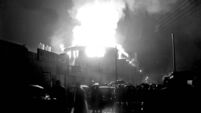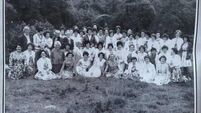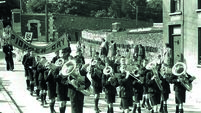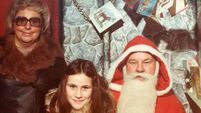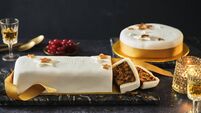A penny for your sweet thoughts! The treats I adored as a child in Cork
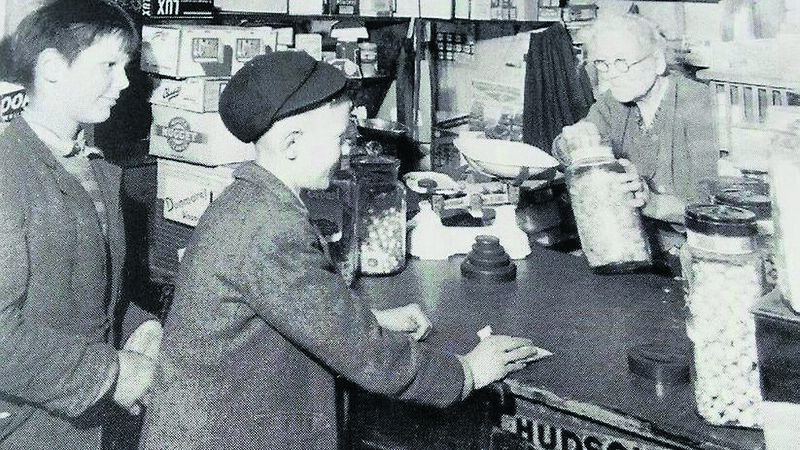
An elderly shopkeeper serving two boys, probably in the 1950s, in a photo sourced in Dungarvan
A penny was a big coin when we were small boys in the 1950s — and it meant a lot to us. If we got one to spend on ourselves, it would be off to the small sweet shop for a penny bar.
Our mother would have other ideas if she got her hands on it — like putting it into our red Royal Mail money box. She used to say when it was full, the lid should fly off by itself... but ours was never tested.
This was because, secretly, we had our own way to raid the pennies from the box, by putting the blade of a knife into the slot, tilting the box until a penny rested on the blade, and then slowly slipping it out!
Remember the names of the penny bars like Sailor’s Chew (with toffee and nuts), Plug Tobacco (bits of coconut and toffee), Pixie Bar (pure dark toffee) and Milky Way (chocolate)?
That valuable penny could also buy a Lucky Ball — a hard ball of sweets that could have a thrupenny-bit hidden in it.
A problem here was that, for every box of 50 Lucky Balls, only two had hidden money in them. In later years, for safety reasons, the hidden coin was changed to a hidden note, to be exchanged for threepence by the shopkeeper.
Loose, hard sweets were six for a penny, with names like Lemon Drops, Clove Rock and Bulls Eyes, and were kept in tall glass jars. The shopkeeper would make a ‘toisheen’ by wrapping a piece of newspaper around her hand to make a cone of it — putting the six sweets into that, then turning in the top so they wouldn’t fall out. It was a cheap way to present the sweets.
A boy named Brendan Maher bought a Lucky Ball with a winning ticket one day on his way back to school after lunch. In those days we ran home at 12.30pm and had to be back for 1.15pm. The notes in this batch of winning Lucky Balls gave the lucky finder a choice of prizes such as a torch, a rugby ball, a story book, or a dinky car.
Brendan felt a winning ticket in his mouth — he had won. He took the rugby ball. We were all overjoyed — although we didn’t even know the rules of rugby. We mucked and tackled down in the commonage of Dunne’s Park in Youghal with the new ball.
Needless to say, our parents were annoyed to see us arrive in daily with mud all over our school clothes —we had no rugby shirts or gear to wear — but imagine the fun we had!
Every town and village had its small sweet shops — I recall Willie Roche’s, Tommy Flavin’s, Mary Murphy’s, Miss Noonan’s, Ted Hegarty’s, Moss Kelly’s, Pasley’s, Maison Fox’s, Freddie Barrett’s, Bill Quirke’s, Nellie Webb’s, Bridgie Quirke’s (where she broke off a couple of squares of slab toffee from a big bar) Anna Lombard’s, Loretto Rohan’s, and don’t forget Jack Daly’s — off the beaten track on Cork Hill.
No wonder we had to get fillings in our teenage years.
Getting sixpence for a cinema matinee meant fourpence admission plus four squares of slab toffee.
A memory comes back to me of cycling one Sunday with pals on the riverside, as far as Lismore. Then, not far beyond Camphire Bridge, was a little shop — like an oasis in the desert to cyclists who had a few pennies to spend. I never heard the owner’s name but it was a great place to stop and take a rest off the old bikes.
Only now can I acknowledge the patience of those who owned those small enterprises. For instance, Tony Cashell of North Main Street, Youghal, lived in behind his shop and had to walk ten yards to serve us. The bars were on display in the window and our choice would be made before going in. Then, standing at the counter, we would bang with our big copper penny on the timber.
It could take a few bangs to alert Tony and he would come out all that way for the sale of a one penny bar. And how long would he be gone back in before another boy knocked on the counter — and Tony could be at his dinner! No small shops closed during the day.
Bernard O’Keeffe’s shop, also on North Main Street, had a fine display of very fancy sweets we could not afford, in spectacular glass jars with large glass covers. They were just to be admired.
He would have chocolates of many kinds, coconut sweets, turkish delight, and large toffees. They were sold by the quarter-pound — and even if they were sold singly, we couldn’t buy one.
The Christian Brothers were teaching us and we would see pairs of them on some evenings going out the road for a walk, but not before they entered Bernard O’Keeffe’s for their chocolates.
Pasley’s had three shops in a row near the Clock-Gate: a bakery, grocery and sweet shop. Kitty Troy worked at the counter and was very kind. They seemed to buy their chocolate in bulk from Cadburys and some of it would be already broken in the box on arrival. Kitty would dispose of this cheaply to poor children.
You could go in to ask Kitty if she had any broken chocolate for sale — sometimes she would have it set aside on a shelf behind her, and other times she could take a perfect bar, break it up, and sell you some broken chocolate for a few pence.
